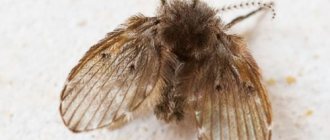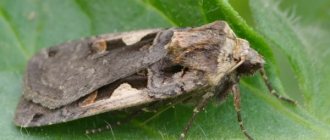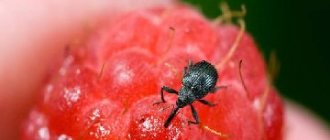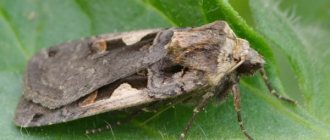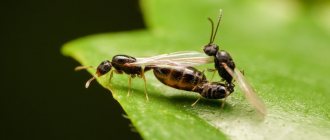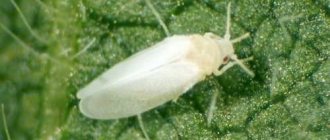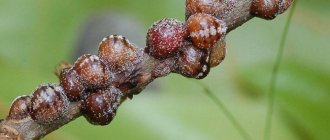Description of the pest
First you need to familiarize yourself with the detailed description and distinctive features of the pest.
Appearance
The main feature of the gall midge is its unremarkable appearance, which makes it difficult to notice. Externally, the pest resembles a small mosquito, the length of which does not exceed five millimeters. The invisibility of the insect is due to its small size and transparent wings. The gall midge is colored grayish with a slight brown tint. The length of small individuals is 1-2 millimeters, so it is almost impossible to detect them on raspberry seedlings in a timely manner.
Reproduction
The reproduction process of such pests has features that are recommended to be familiarized with in advance. During breeding, adult females begin to lay eggs, the surface of which is colored green with a light green tint. Most often, eggs are laid under the bark of stems, in places of mechanical damage. Over time, larvae emerge from the eggs, which turn orange as they mature. The length of such larvae reaches two millimeters. Young individuals develop and overwinter under the bark.
Why is stem gall midge dangerous for raspberries?
Some people are not even aware of the serious danger that gall midges pose to young raspberry seedlings. The most dangerous are the larvae that live inside the stem. They feed on plant sap, which causes the shoots to slow down their development. If there are too many larvae, the affected branch begins to dry out and die.
It is necessary to get rid of the larvae in a timely manner, as they can destroy a shoot or even an entire bush within 2-3 months.
Shoot gall midge
When gall midge larvae are present in raspberry stems, the plant literally turns into dust. The growths can most often be seen at the base of the stems, where the bark is already cracked. Since the larvae drink the plant sap, the shoots simply dry out, easily break and must be removed. After a gall midge attack, cones may appear throughout the summer season. When a raspberry tree is massively infected, there is not just one growth on one shoot, but up to five to seven. But even one gall is enough to weaken the plant, which subsequently must be disposed of.
When the shoot is broken, a yellow larva is found at the site of the growth, although depending on the raspberry variety, its color may be different. First, the parasite develops inside the galls, and as it is fed with juice, it begins to move in a spiral direction. The larva pupates in the soil and crawls to the surface in the form of a mosquito.
Mature females again lay eggs in small cracks in the bark of the shoots. In one season, gall midge infestation of raspberries occurs continuously, since the life cycle of these insects thus constantly continues. During the growing season, more than one generation of pests changes in the raspberry field. The shoot gall midge overwinters not inside the stem, but under the soil at a depth of thirty centimeters. Thus, the invasion of these insects can cause infection of a significant area of the summer cottage in breadth and depth.
Despite the fact that the larvae are legless, they move quickly. If you notice a gall midge on the surface of the soil, then after a couple of minutes there will be no trace left of its presence, since the larva will head into the ground.
How to deal with shoot gall midge
Based on the observations of a large number of gardeners, it becomes clear that most often the gall midge lays eggs on infected raspberry bushes. One of the types of diseases that attract mosquitoes is didimella raspberry, which is popularly called blight. This disease itself weakens the plants, as can be seen by the lethargy of the stems and spots on the leaves. The raspberries begin to emit an aroma that the gall midge cannot fly past. Thus, in order to protect the raspberry plant from the scourge of these small mosquitoes, it is necessary to carefully inspect the plants for the presence of other diseases.
The lower buds on raspberries, as a rule, are unproductive, so after blooming they can be safely cut off. This procedure is carried out in the spring, and the cutting height depends on the total length of the stem. To trim raspberries, take pruning shears or sharp regular scissors, which are used to remove buds up to a height of seventy centimeters.
The fight is primarily aimed at collecting the larvae and eggs located inside the kidneys.
After pruning, a one percent solution of Bordeaux mixture is applied to the stems. This is done so that the fungicide can prevent the development of fungal disease. Thus, after spraying, the raspberries will be protected from several misfortunes at once. When young replacement shoots begin to grow, the lower leaves are cut off and excess growth is also removed.
In order to ensure that the gall midge has nowhere to settle, those stems that have already produced a harvest are cut out from the raspberry field.
For varieties with early berries, this procedure is carried out at the beginning of the summer season. Medium varieties are pruned a little later, and removal of late raspberry shoots may take until autumn. Exposed stems should be sprayed again with a fungicide that contains copper. Replacement shoots and shoots up to the first leaves are also subject to treatment. Spraying raspberries is best done on a windless evening. In this way, gall midges are prevented on shoots, as well as didimella.
Remontant raspberries are less susceptible to gallworm infection than annual varietal plants. If, after spraying, growths were noticed in the upper part of the stems, it means that the female shoot gall midges began to lay eggs higher than usual. It is easier for a gardener to detect such cones, so plants should be inspected at least once a week. If there are raised growths, try cutting the shoot to remove the larva. If this cannot be done, or the larva has already gone into the ground, then such shoots are cut two centimeters below the location of the bud and then burned.
Causes
To prevent the appearance of gall midges, it is necessary to become familiar with the causes of their occurrence. These include the following:
- the use of a large amount of nitrogen fertilizers, due to which the bark on the stems begins to peel off;
- poor-quality thinning of plantings, due to which they begin to weaken;
- poor ventilation, leading to increased humidity levels and the development of gall midges.
See also
When can you collect raspberry leaves for drying for the winter, terms and rules and where to storeRead
Prevention
Prevention of the spread of gall midges in raspberry fields includes the following measures:
- Careful selection of exclusively healthy seedlings for planting. Damaged planting material is discarded.
- Selecting a raspberry variety that is resistant to the pest. For example, Creed, Phenomenon, Faith. The gall midge avoids these varieties. Another option is to choose only remontant varieties for planting. Complete autumn removal of shoots will help prevent the development of stem gall midges in the raspberry forest.
- Avoid thickening the raspberry plantings. To do this, they carry out sanitary pruning in a timely manner and practice growing raspberries on trellises. The sun's rays should penetrate deep into the bush.
- Fragrant plants are planted around the raspberry plantation. The insect cannot tolerate the aromas of onions, parsley, dill, and garlic. Repellent plants need to be planted in such a way that they grow next to the raspberry tree all season. But it should be taken into account that this measure is effective only in combination with others, and parsley alone in a raspberry garden will not save you.
- Raspberries should not be filled with water in large quantities. High humidity levels stimulate the development of larvae and attract gall midges. For the same reason, bushes are not planted in lowlands where moisture accumulates.
- To get rid of the insect and prevent it from overwintering quietly, the soil around the raspberries must be loosened, especially before winter, or dug up shallowly.
- It is advisable to use pine sawdust as mulch. Soil covered with mulch material will be inaccessible for wintering for most pests. The resinous smell of pine needles will repel insects.
The appearance of Galitsa on raspberries almost always indicates incorrect agricultural practices and neglect of the garden. If you follow all the recommendations listed, the appearance of gall midges on the plantation can be reduced to zero.
Signs of appearance
In order to detect stem gall midge in a timely manner, you need to become familiar with the main signs of its manifestation. The first sign that a seedling is affected by a pest are galls located under the surface of the tree bark. More than five larvae develop in one such stem thickening. They grow there until the end of autumn, after which they move along the stem to the root system.
Another sign of the appearance of pests is the drying out of the shoots. At first they begin to turn yellow, but over time the stems dry out.
What harm does it do?
The main harm from gall midges is the destruction of raspberry stem tissue. The larvae eat away the inside of the plant, which eventually turns into dust.
Cones with stem gall midge larvae may appear from mid- or late August to mid-November, depending on the climatic conditions of the region. If during this time you do not inspect the raspberry tree and do not rid it of pests, the overwintered gall midge in the spring, with its active actions, may simply not leave any living space on the shoots.
The shoot gall midge must be combated from early spring until late autumn, so as not to lose the raspberry harvest. Stem gall midges are less common on raspberries.
How to deal with the pest?
If a gall midge has been spotted on raspberries, you must immediately begin to fight it.
Chemicals
Most often, pest control is carried out using special chemicals.
Insecticide "Iskra"
Often, when spraying raspberry bushes, the Iskra insecticide is used. This product is produced and sold in the form of tablets, which must be mixed with water before use. To protect seedlings from pests, one and a half liters of mixture is consumed for every ten square meters. When using Iskra, it is not necessary to use gloves, since the composition is non-toxic.
"Karbofos"
"Karbofos" is considered an old and proven remedy for combating dangerous insects. This product is effective and therefore is used even to kill bedbugs. The disadvantages of Karbofos include its toxicity, due to which the treatment is carried out in protective equipment. Spraying is carried out no more than once per season.
Non-systemic organophosphorus insectoacaricide "Aktellik"
This is a drug that has an intestinal contact effect. It is used to protect garden and garden crops from dangerous insects. Among the advantages of the product are its effectiveness, duration of protective action and low level of toxicity. You should use Actellik no more than once a month.
Traditional methods
There are three effective folk remedies that can be used when fighting insects:
- Tansy tincture. To prepare the product, pour 400 grams of the plant with 5-6 liters of boiling water. Then everything is infused for 2-3 days, filtered and stirred with 9-10 liters of water.
- Urea. When creating a mixture for treating shrubs, mix 10 milliliters of urea and 10 liters of water.
- Garlic infusion. Half a kilogram of garlic heads is crushed in a meat grinder, filled with water and left for a week. The mixture is then filtered and used for spraying.
See also
Description and characteristics of the Maroseyka raspberry variety, cultivation and careRead
Other ways to prevent gall midges on raspberries
To protect raspberries from pests, purchased fungicides are used, as well as solutions made by people. In most cases, more than one raspberry patch, as well as neighboring ones, fall under the invasion of gall midges, since the raids are carried out by a whole swarm of insects.
Experienced gardeners recommend the following measures that can prevent crop loss:
- Before flowering, raspberries are treated with poisonous insecticides, which are designed specifically to combat gall midges. After applying the drug to the plant, the shoots are impregnated with a deadly liquid for insects. For example, the insecticide "Calypso" effectively acts for a month on sucking raspberry pests by paralyzing their nervous system. After three hours, the gall midge dies. By the way, plants treated with Calypso poison do not pose a danger to bees.
- Preparations with a similar effect on gall midge mosquitoes include the Karate insecticide, which penetrates through food and directly upon contact. The effect appears after a few minutes.
- No less toxic to the gall midge is Karbofos, or rather the malathion included in its composition. The effect of this drug is visible almost instantly, and the duration of the effect is up to one month, so you cannot pick the berries earlier.
- To prevent the gall midge from being attracted by the aroma of raspberries, repellent traditional infusions are used. Solutions with bird cherry, infusions of tobacco, wormwood, nettle, or garlic scent will help protect the planting of raspberries from gall midges. Such infusions are easy to make: take at least a kilogram of the listed greens in a bucket of water and let it sit for a couple of days. Before spraying, add finely chopped laundry soap in the amount of fifty grams. The prepared solution is thoroughly mixed and the liquid part is separated, which is used to treat the raspberry bushes in the evening.
- Trimming the stems will also serve as a kind of protection against the appearance of gall midges. If the bush has grown, no more than two replacement shoots are left on it, and sometimes this is enough for gall midge eggs to get into the raspberry bush.
- Plant hardy plant varieties that are less susceptible to pests.
- Perennial onions or garlic are planted between the raspberry rows. These plants emit pungent aromas that repel gall midges.
When a summer cottage with raspberries is located near other plantings of these berry plants, the group work of gardeners brings effective results. Coordinated action to combat gall midges prevents the seasonal invasion of mosquitoes, keeping the crop in good condition.

